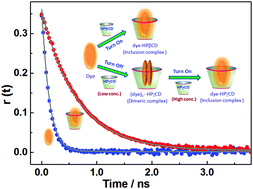当前位置:
X-MOL 学术
›
New J. Chem.
›
论文详情
Our official English website, www.x-mol.net, welcomes your feedback! (Note: you will need to create a separate account there.)
Contrasting interactions of DNA-intercalating dye acridine orange with hydroxypropyl derivatives of β-cyclodextrin and γ-cyclodextrin hosts†
New Journal of Chemistry ( IF 3.3 ) Pub Date : 2018-12-03 00:00:00 , DOI: 10.1039/c8nj04067b Mhejabeen Sayed 1, 2, 3 , Ganesh K. Gubbala 1, 2, 3 , Haridas Pal 1, 2, 3
New Journal of Chemistry ( IF 3.3 ) Pub Date : 2018-12-03 00:00:00 , DOI: 10.1039/c8nj04067b Mhejabeen Sayed 1, 2, 3 , Ganesh K. Gubbala 1, 2, 3 , Haridas Pal 1, 2, 3
Affiliation

|
Acridine orange, a well known DNA intercalating dye, exists in two prototropic forms, the cationic form AOH+ and neutral form AO. Systematic investigations on the interactions of AO and AOH+ with two homologous cyclodextrin derivatives, hydroxypropyl-β-cyclodextrin (HPβCD) and hydroxypropyl-γ-cyclodextrin (HPγCD), having different cavity sizes, reveal interesting modulations in the photophysical and acid–base properties of the dye. Ground state absorption, steady-state fluorescence, circular dichroism and time-resolved fluorescence studies have documented quite contrasting changes in the photophysical properties of both AO and AOH+ in their interaction with HPγCD as compared to HPβCD. Results indicate that while 1 : 1 inclusion complexes are only formed using HPβCD, leading to significant fluorescence enhancement for both AO and AOH+, the use of HPγCD on the other hand assists dimerization of both AO and AOH+ at lower HPγCD concentration, resulting in significant fluorescence quenching initially, and subsequently there is a clear conversion of the dimeric dye–host complexes to 1 : 1 dye to host inclusion complexes at higher HPγCD concentration, causing a significant enhancement in fluorescence intensity. To the best of our knowledge this is the first report to document sequential fluorescence quenching and enhancement for both neutral and protonated forms of a dye with gradually increasing host concentration. Both HPβCD and HPγCD hosts cause a significant downward pKa shift for acridine orange dye and the results are in accordance with the stronger binding of the neutral AO form with the studied hosts as compared to the cationic AOH+ form of the dye.
中文翻译:

DNA嵌入染料a啶橙与β-环糊精和γ-环糊精主体的羟丙基衍生物的对比相互作用†
cr啶橙,一种众所周知的DNA嵌入染料,以两种质子传递形式存在,阳离子形式AOH +和中性形式AO。系统研究了AO和AOH +与两种同源环糊精衍生物羟丙基-β-环糊精(HPβCD)和羟丙基-γ-环糊精(HPγCD)的相互作用,它们具有不同的空腔尺寸,揭示了光物理性质和酸碱性质的有趣调控染料。基态吸收,稳态荧光,圆二色性和时间分辨荧光研究已证明AO和AOH +的光物理性质发生了截然不同的变化与HPβCD相比,它们与HPγCD的相互作用。结果表明,虽然仅使用HPβCD形成1:1包合物,导致AO和AOH +的荧光均显着增强,但同时使用HPγCD有助于AO和AOH +的二聚化。在较低的HPγCD浓度下,最初会导致显着的荧光猝灭,随后在较高的HPγCD浓度下,二聚体染料-主体配合物向1:1染料明显转变为主体包合物,导致荧光强度显着增强。据我们所知,这是第一份报告,证明随着宿主浓度的逐渐增加,中性和质子化染料的顺序荧光猝灭和增强。HPβCD和HPγCD主体均引起a啶橙染料的显着向下p K a移位,并且结果是与染料的阳离子AOH +形式相比,中性AO形式与所研究的主体之间的结合力更强。
更新日期:2018-12-03
中文翻译:

DNA嵌入染料a啶橙与β-环糊精和γ-环糊精主体的羟丙基衍生物的对比相互作用†
cr啶橙,一种众所周知的DNA嵌入染料,以两种质子传递形式存在,阳离子形式AOH +和中性形式AO。系统研究了AO和AOH +与两种同源环糊精衍生物羟丙基-β-环糊精(HPβCD)和羟丙基-γ-环糊精(HPγCD)的相互作用,它们具有不同的空腔尺寸,揭示了光物理性质和酸碱性质的有趣调控染料。基态吸收,稳态荧光,圆二色性和时间分辨荧光研究已证明AO和AOH +的光物理性质发生了截然不同的变化与HPβCD相比,它们与HPγCD的相互作用。结果表明,虽然仅使用HPβCD形成1:1包合物,导致AO和AOH +的荧光均显着增强,但同时使用HPγCD有助于AO和AOH +的二聚化。在较低的HPγCD浓度下,最初会导致显着的荧光猝灭,随后在较高的HPγCD浓度下,二聚体染料-主体配合物向1:1染料明显转变为主体包合物,导致荧光强度显着增强。据我们所知,这是第一份报告,证明随着宿主浓度的逐渐增加,中性和质子化染料的顺序荧光猝灭和增强。HPβCD和HPγCD主体均引起a啶橙染料的显着向下p K a移位,并且结果是与染料的阳离子AOH +形式相比,中性AO形式与所研究的主体之间的结合力更强。



























 京公网安备 11010802027423号
京公网安备 11010802027423号